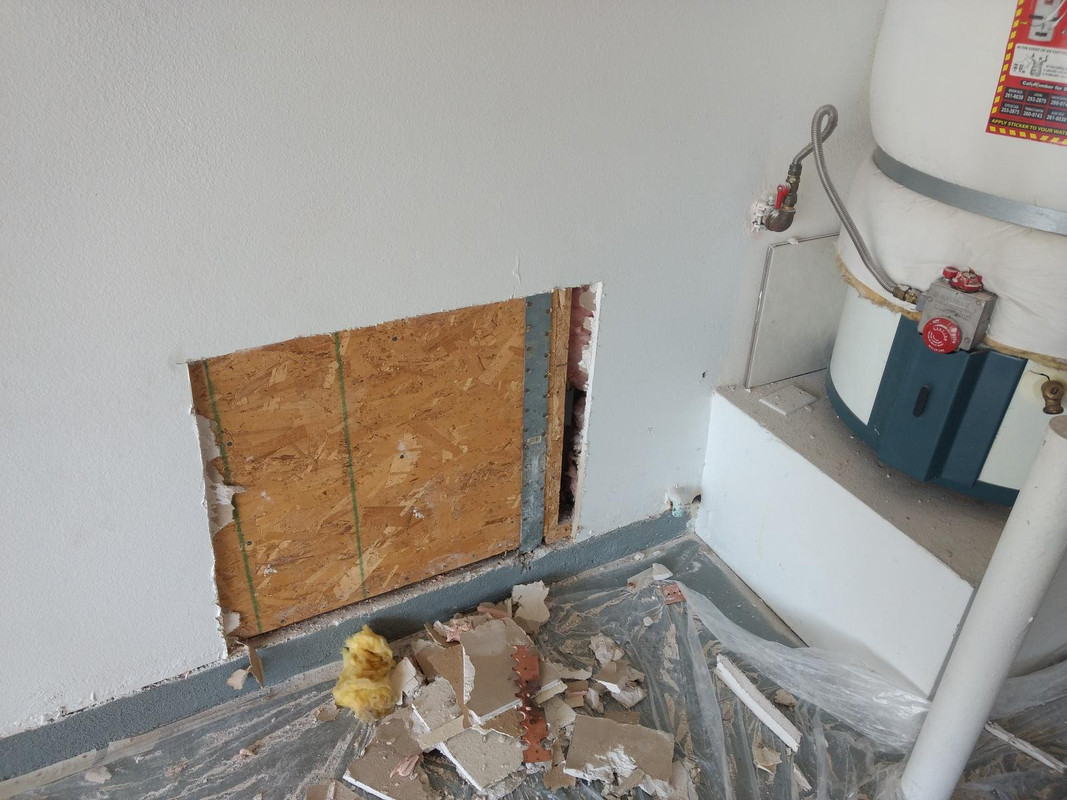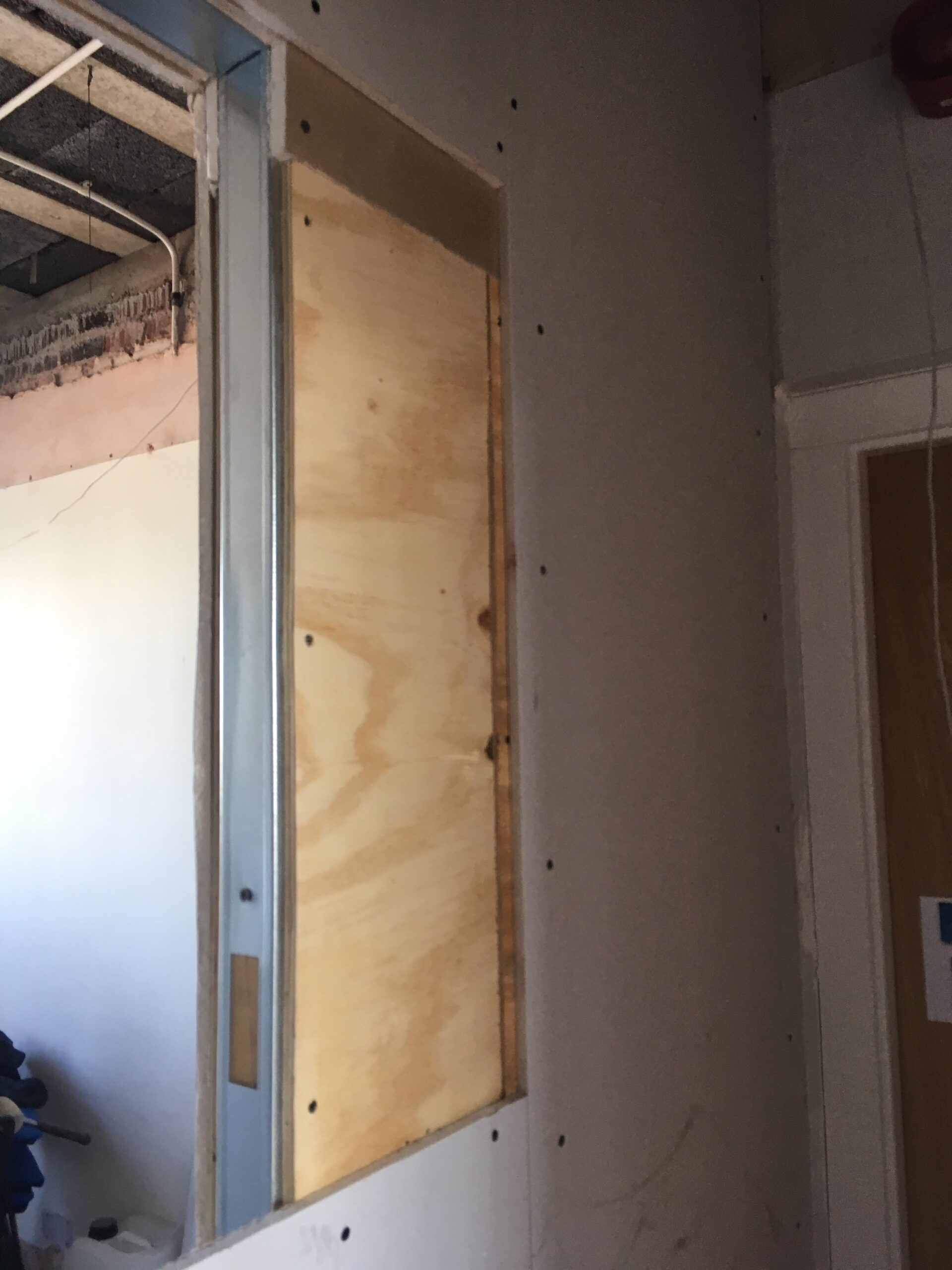Do you ever wonder why there’s plywood behind drywall? Well, you’ve come to the right place to find out! In this article, we’ll explore the reasons behind the presence of plywood behind your walls and shed some light on this fascinating topic.
You might be wondering, “Why on earth would anyone want to put plywood behind drywall?” It turns out that plywood serves an important purpose in supporting and reinforcing the structure of your walls. So, if you’ve ever noticed a layer of wood behind your drywall, don’t worry, it’s not a mistake!
So, let’s dive deeper into the world of construction and discover why there’s plywood hiding behind your walls. Get ready to uncover the secrets of plywood and its role in ensuring your walls stay strong and sturdy!
Have you ever wondered why there’s plywood behind drywall? Here’s the answer: plywood is sometimes used as a backing material for added strength and support. This is common in areas where heavy fixtures or equipment like shelves or cabinets will be installed. Plywood provides a solid surface to anchor these items securely. So, the next time you come across plywood behind drywall, know that it’s there to provide stability and ensure durability.

Why Is There Plywood Behind Drywall?
What is Plywood and Drywall?
Plywood is a type of engineered wood made from thin layers of wood veneers, which are glued together with the grains running perpendicular to each other. This construction gives plywood its strength and durability. On the other hand, drywall, also known as gypsum board or plasterboard, is a panel made of calcium sulfate dihydrate (gypsum) sandwiched between two layers of paper. It is commonly used to create interior walls and ceilings in residential and commercial buildings.
Now that we have a basic understanding of plywood and drywall, let’s dive into why plywood is often found behind drywall.
Structural Stability and Support
One of the main reasons plywood is used behind drywall is to provide structural stability and support. Drywall itself is relatively fragile and can easily crack or break under pressure. By installing plywood as a backing material, it helps distribute the load across a larger surface area, reducing the likelihood of damage to the drywall. Plywood also adds strength to the overall structure, especially in areas where heavy fixtures or equipment, such as cabinets or wall-mounted TVs, will be installed.
Additionally, plywood acts as a base to attach the drywall securely. The layers of plywood are screwed or nailed into the studs, creating a solid surface for the drywall to be attached to. This ensures that the drywall remains firmly in place, even when subjected to everyday wear and tear or slight movements in the building.
Overall, the presence of plywood behind drywall enhances the structural integrity of walls and ceilings, making them more robust and capable of withstanding various forces.
Soundproofing and Insulation
Another benefit of having plywood behind drywall is improved soundproofing and insulation. Plywood has natural sound-dampening properties, which helps reduce noise transmission between rooms. By adding plywood as a layer between rooms or along exterior walls, it can minimize sound transfer, providing a more peaceful and comfortable living or working environment.
Moreover, plywood can enhance the insulation properties of the wall. It acts as an additional barrier to heat loss or gain, helping to maintain a consistent indoor temperature and reduce energy consumption. This is particularly beneficial in regions with extreme climates, as it helps make the building more energy-efficient, lowering heating and cooling costs.
By utilizing plywood behind drywall, homeowners and building occupants can enjoy enhanced acoustic performance and better thermal insulation.
Fire Resistance and Safety
Plywood also contributes to the fire resistance and safety of buildings. Drywall itself has a certain degree of fire resistance due to the gypsum core, but plywood provides an added layer of protection. Plywood is inherently fire-resistant, and when used in conjunction with fire-rated drywall, it can significantly increase the fire resistance of walls and ceilings.
During a fire, plywood delays the propagation of flames and helps prevent the fire from spreading to other areas of the building. This extra time can be crucial for occupants to safely evacuate and for firefighters to extinguish the flames. Additionally, plywood has a lower propensity to emit toxic gases when exposed to fire, further enhancing the safety of the building’s occupants.
Considering the importance of fire safety, the incorporation of plywood behind drywall is a prudent choice in both residential and commercial constructions.
Cost-Effectiveness and Versatility
Using plywood as a backing material behind drywall also offers cost-effectiveness and versatility. Plywood is relatively affordable compared to other building materials, making it an economical choice for large-scale construction projects. It provides a sturdy and reliable surface for drywall installation at a fraction of the cost of alternative options.
Furthermore, plywood can accommodate various types of finishes, such as paint, wallpaper, or wall tiles, making it a versatile substrate for interior design. It allows for easy customization and updates to the wall’s appearance without the need for extensive modifications.
By utilizing plywood behind drywall, builders and homeowners can achieve cost savings without compromising on quality or aesthetics.
Environmental Considerations
Lastly, the use of plywood behind drywall aligns with environmental considerations. Plywood is made from a renewable resource, wood, which can be sustainably harvested and replanted. Many plywood manufacturers adhere to responsible forestry practices, ensuring the long-term viability of forests.
In addition, plywood is a durable material that can last for decades with proper maintenance. This longevity reduces the need for frequent replacements, minimizing waste and the environmental impact associated with manufacturing new materials.
Choosing plywood as a backing material behind drywall contributes to sustainable construction practices and helps reduce the carbon footprint associated with the building industry.
Benefits of Having Plywood Behind Drywall
Improved Structural Integrity
By having plywood installed behind drywall, the structural integrity of walls and ceilings is enhanced. This provides a solid and stable surface for the drywall to be attached to, reducing the chances of cracks, sagging, or other damage. It also allows for the secure installation of heavy fixtures and equipment, ensuring they remain in place without compromising the integrity of the drywall.
Enhanced Soundproofing and Insulation
Plywood acts as an additional barrier to sound transmission between rooms, providing better acoustic performance. It helps minimize noise disturbances, creating a quieter and more peaceful environment. Plywood also adds insulation properties to the wall, reducing heat loss or gain and improving energy efficiency. This leads to more consistent indoor temperatures and lower utility bills.
Increased Fire Resistance
Using plywood behind drywall enhances the fire resistance of walls and ceilings. Plywood is inherently fire-resistant and can significantly delay the spread of flames. When combined with fire-rated drywall, it provides an added layer of protection, increasing the safety of occupants and allowing more time for evacuation and firefighting efforts.
Cost-Effective and Versatile
Plywood is a cost-effective option for backing material, offering durability and strength at a reasonable price. It is versatile and compatible with various interior finishes, allowing for customization and design flexibility. Additionally, plywood can be easily sourced and installed, saving time and effort during the construction process.
Sustainable Building Choice
By using plywood behind drywall, builders contribute to sustainable construction practices. Plywood is made from a renewable resource and can be responsibly harvested. Its durability and longevity reduce waste and the need for frequent replacements, minimizing the environmental impact of the construction industry.
Tips for Using Plywood Behind Drywall
Choose the Right Plywood
When selecting plywood for use behind drywall, ensure it meets the necessary standards and requirements. Look for plywood that is specifically designed for construction purposes and has appropriate fire resistance ratings if needed. Consider the thickness and strength of the plywood to ensure it provides adequate support for the drywall and any fixtures or equipment that will be attached to it.
Proper Installation
Make sure the plywood is installed correctly to achieve maximum effectiveness. Attach the plywood to the studs using appropriate fasteners, such as screws or nails, ensuring a secure and even attachment. Take care to align the edges of the plywood properly to create a seamless surface for the drywall installation.
Consider Additional Safety Measures
While plywood enhances fire resistance, it’s always a good idea to include other safety measures in your building design. Install smoke detectors, fire extinguishers, and a sprinkler system to further ensure the safety of occupants. Regularly inspect the plywood and drywall for any signs of damage or deterioration, and address them promptly to maintain the integrity of the walls and ceilings.
In summary, plywood is often used behind drywall for its structural stability, soundproofing, insulation, fire resistance, cost-effectiveness, and environmental benefits. It provides a solid backing material for the drywall, enhancing its strength and durability. Plywood also offers improved soundproofing and insulation properties, creating a quieter and more energy-efficient space. Additionally, plywood increases the fire resistance of walls and ceilings, contributing to the safety of building occupants. It is a cost-effective option that allows for versatile design options and aligns with sustainable building practices. By following proper installation techniques and considering additional safety measures, the use of plywood behind drywall can be optimized for maximum effectiveness and longevity.
Key Takeaways: Why is there plywood behind drywall?
- Plywood is often used as a backing material behind drywall for added strength and support.
- Plywood helps to prevent the drywall from cracking or sagging over time.
- Plywood can also act as a base for attaching heavy objects or fixtures to the wall.
- Having plywood behind drywall provides a solid surface for hanging pictures or shelves securely.
- Plywood increases the overall durability and stability of the wall, especially in areas prone to high impact or vibrations.
Frequently Asked Questions
When it comes to drywall, have you ever wondered why there is plywood behind it? We’ve put together some common questions and answers to help you understand this construction technique.
Q1: What is the purpose of having plywood behind drywall?
A1: The plywood behind drywall serves two main purposes. First, it provides additional structural support to the wall, making it sturdier and less prone to damage. This is especially important in areas with heavy loads or movements, such as around doors or windows. Second, the plywood acts as a base for attaching the drywall, offering a more secure and stable surface.
By using plywood as a backing material, contractors can ensure that the drywall remains securely in place and can withstand pressure or impact without cracking or breaking. It also helps to minimize any irregularities in the wall’s surface, creating a smoother finish.
Q2: Is plywood always used behind drywall?
A2: No, plywood is not always necessary behind drywall. It depends on the specific needs of the project and the structural requirements of the building. In some cases, such as with interior walls in residential homes, plywood may not be required as the wall structure itself provides sufficient support for the drywall.
However, in situations where the wall may experience additional stress or have specific load-bearing requirements, plywood may be used to reinforce the wall. For example, in commercial buildings or areas with large openings for windows, plywood backing is often employed to give the drywall added strength and durability.
Q3: How is plywood attached behind drywall?
A3: Plywood is typically attached to the wall studs using nails or screws. Before installation, the plywood sheets are cut to fit the dimensions of the wall. Once the plywood is properly aligned and leveled, it is fastened to the studs at regular intervals, ensuring a secure attachment.
Once the plywood is in place, the drywall is then installed over it. The drywall panels are screwed or nailed onto the plywood in a staggered pattern, usually starting from the center and working towards the edges. This method allows for a strong and even distribution of the drywall’s weight across the plywood surface, preventing sagging or bulging.
Q4: Does the thickness of the plywood matter?
A4: Yes, the thickness of the plywood used behind drywall can vary depending on the specific requirements of the project. Thicker plywood, such as 3/4-inch or 1-inch, is often used in areas that require more structural support or in commercial buildings with higher load-bearing capacities.
However, for most residential applications, 1/2-inch plywood is commonly used. This thickness provides adequate strength without adding unnecessary weight or cost. It is important to consult with a professional contractor or engineer to determine the appropriate plywood thickness for your specific project.
Q5: Can other materials be used instead of plywood?
A5: While plywood is the most commonly used material behind drywall, there are alternative options available. One such alternative is oriented strand board (OSB), which is made from wood strands compressed and bonded together to create a strong and durable panel.
OSB can be a cost-effective alternative to plywood, especially in areas where structural integrity is essential. However, it is worth noting that the performance of OSB may vary depending on the specific product and its application. It is always recommended to consult with a professional to determine the most suitable material for your project.

Sheathing The New Shop With Plywood AND Drywall! | Walker’s Woodworks New Shop Build Out Pt. 3
Summary
So, why is there plywood behind drywall? It’s because plywood provides additional strength and stability to the walls. The plywood acts as a secure base for attaching heavy items like cabinets or shelves. Additionally, it helps prevent damage from accidental impacts or natural disasters like earthquakes.
Not only does plywood add structural support, but it also enhances soundproofing. By having a layer of plywood behind the drywall, it helps to reduce noise transmission between rooms. This can create a quieter and more peaceful environment in your home. So, the plywood serves multiple purposes, making your walls stronger and reducing noise at the same time.
